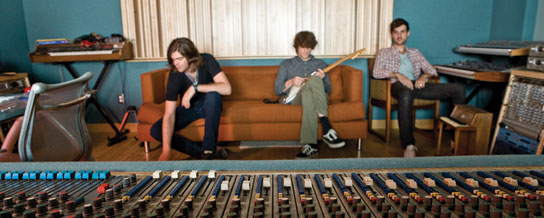In the Studio: The Faint
Nearly a decade ago, Omaha, Nebraska-based electro-rock outfit The Faint popularized the white-belt-and-black-bangs aesthetic, but […]

In the Studio: The Faint
Nearly a decade ago, Omaha, Nebraska-based electro-rock outfit The Faint popularized the white-belt-and-black-bangs aesthetic, but […]

Nearly a decade ago, Omaha, Nebraska-based electro-rock outfit The Faint popularized the white-belt-and-black-bangs aesthetic, but possibly even more noteworthy, they reintroduced the synthesizer into the jaded punk-by-way-of-indie-rock subculture. Perhaps single-handedly inspiring the term “dance punk,” The Faint hit the synths harder than Gary Numan in his prime, all while keeping time with their gritty, guitar-wielding Saddle Creek contemporaries. Their albums–Blank-Wave Arcade, Danse Macabre, and Wet From Birth–saw the band shapeshifting from Kraftwerkian robot rockers to second-generation New Wave purveyors in just a few short years.
So what does a group of ex-skateboarding indie kids do when they go from punk rags to pop riches? Buy a studio, for starters. The group opted to honor their punk heritage by producing Fasciinatiion (their first record in over four years) themselves at their own Enamel Studio, doing all of the artwork themselves, and splitting from indie Saddle Creek to self-release the album via their own Blank.Wav imprint. XLR8R caught up with synth player/production captain Joel Petersen and singer Todd Fink to talk synths, side-projects, and moving up the DIY production foodchain.
XLR8R: How has your recording changed now that you have your own studio?
Joel Petersen: When we recorded Blank-Wave Arcade, we recorded nothing direct–all keys went through amps. Usually we used some crappy Peavy bass amp or something, but that’s what we were working with at the time, what we were used to, and the way we wanted to sound. We were playing a lot of basement shows and we wanted to capture that spirit. With Fasciinatiion, we decided to do everything direct and as mixing started happening, rather than reaching for an EQ knob, we added in those growling, biting synths through amps. It adds that punkness, keeps things from sounding cold and sterile, and puts a little bit of room (and human) back into the recording process.
What new production resources make Fasciinatiion particularly memorable?
JP: Our studio itself shaped everything we did. It’s comprised of all kinds of gear and instruments, but we treat it as one big thing. It’s in a building we own in downtown Omaha. Whether it’s the different isolation rooms or one piece of gear, it’s really about us using this studio to make new songs. It feels different because it’s ours. I don’t know if it’s the paint or whatever but we love it. This band has, in one way or another, become our lives and our studio is really an extension of that.
How important have vocal and instrumental effects been in recording?
Todd Fink: For this record, we fucked around with Melodyne software a lot with vocals. It’s like an AutoTune program. You can put any kind of track into it, transpose the octaves, harmonize them, and make anything sound like a new instrument or gender. We used it on a subtle level with bass, but when something wasn’t working right, we’d be like, “Let’s just put it through this thing.” It’s most visible on the slow song “Fish in the Womb”; you can hear the vocals getting dragged around and skewed. Like any other studio, sometimes you may have an idea that seems completely unreasonable, but those can be the most important to try. [It’s about] running one thing into another thing and hoping for the time when it’s like, “Whoa, what the fuck is that sound?”
What role do vintage synths play in your studio?
JP: It always depends on what we’re going for. Our thought process typically starts like this: Hopefully we can work with vintage keys, then it goes to modern analog synths, and plug-ins are generally a last resort. With some vintage stuff, you can’t do the tight-themed LFO tricks you can do with a modern keyboard. Everything has a time and a place and when it works it works. The one piece of gear I return to more often than not is the Doepfer A-100 Analog Modular synth… which I usually use for an effects device rather than a synthesizer.
What’s your preferred software? Do you use any different platforms for remixes?
TP: We used Pro Tools to record most of the album, but we love Ableton Live and would like to use it more. Individually we all love remixing and as a band we’ve done them for Yeah Yeah Yeahs and Nine Inch Nails. Right now, we’re talking about doing a Kills remix. Jacob [Thiele] and I are starting a remix group called Depressed Buttons–we’ve kind of got a name now from DJing after Faint shows. Clark [Baechle] does remixes as Recordist, Joel does Broken Spindles, and Dapose does Werewolf Grave, which sounds like Aphex Twin and Cephalic Carnage!

